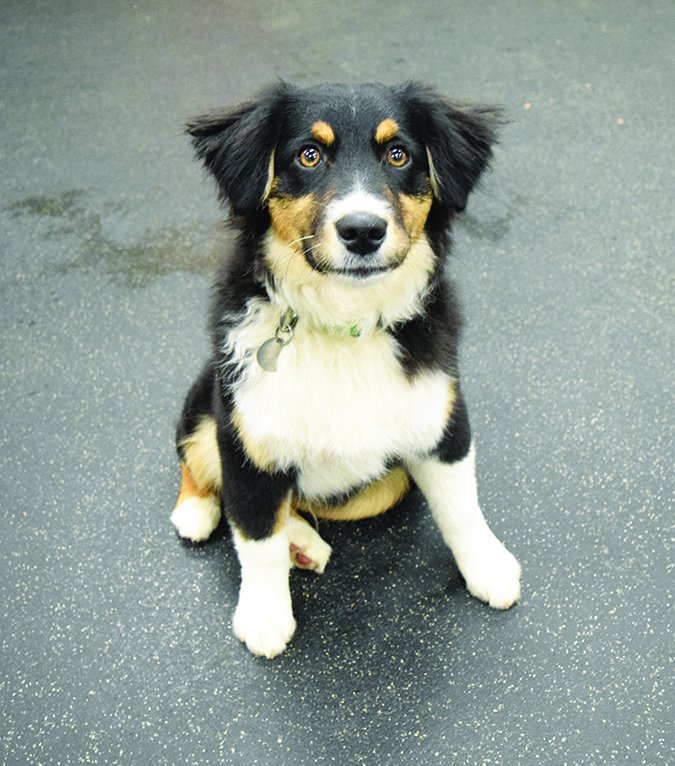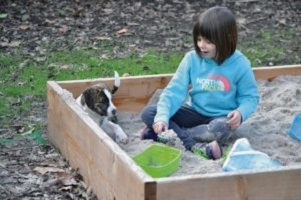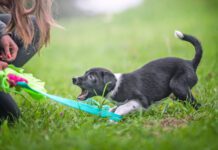I don’t care what breed or mix of breeds you’re talking about, puppies are inarguably, impossibly and adorably cute. You have to be pretty hardhearted and cold or otherwise emotionally damaged not to get gushy over baby dogs, with their innocent faces, sweet puppy breath, satiny ears, and soft pink paw pads. It’s no wonder that people adopt or purchase them, take them home, and then all too often don’t know how to properly care for them.
It shouldn’t surprise me but it does, still, that there are far too many people out there who don’t seem to have a clue about how to properly raise a puppy. Whole Dog Journal readers are not likely to fall into the “completely clueless” category, but in case you haven’t had a puppy for a while – or ever – and recently adopted or are thinking of adopting, here’s a refresher course for you on the topic of the 10 most important things you should teach your puppy.
1. Socialize Your Puppy to Many Situations
If you teach her nothing else, teach your puppy that the world is a safe and happy place. The formal name for this process is “socialization,” and it means taking your puppy lots of places, exposing her to different sights, sounds, surfaces, humans and other animals, and making sure she’s having a good time while doing so. You want to give her a positive classical association with the world and all things she’s likely to encounter in her dog life. Lots of people understand the part about taking their puppy lots of different places for socialization. They sometimes miss the critically important part: making sure the puppy has a good time.
The primary socialization window is alarmingly small – from three to four weeks to about 13 to 14 weeks. If you get your pup at age eight weeks, half that period is already gone – so hopefully the owner of the pup’s mother has already laid a good socialization foundation. Now it’s your turn.
Take your puppy to safe places where you can control the environment to a reasonable degree. Loud parties and crowded street fairs are not a good idea. Small social gatherings, controlled groups of children, and well-run force-free puppy classes are. Find businesses that welcome pets (many hardware stores and outdoor cafes are pet-friendly) and take her shopping with you (but don’t leave her in a hot car!).
If she seems fearful at any time, move her away from the fear-causing stimulus, let her observe from a safe distance, and feed high-value treats to help her have a good association with the thing, whatever it is. Then make a mental note (or keep a written list!) of things you want to help her become more comfortable with by doing focused counter-conditioning sessions.
For more information, see “Properly Socializing Your Puppy.”
2. Prevent Separation Anxiety by Leaving Your Puppy Alone
Dogs are social animals. In a world not controlled by humans, our dogs would spend most of their time in the company of others. Feral dog populations show us that, while not a true pack in the “wolf” sense of the world, wild dogs tend to exist in loose-knit social groups and do choose to be in the company of others of their own kind. In contrast, in our world, a significant population of canines are “only dogs” and are left home alone for eight to 10 hours or even longer. The incidence of separation and isolation anxiety behaviors (SA and IA) in our canine companions is sad testimony to this.
To avoid inducing SA or IA in your pup, introduce her to “aloneness” gradually. Include crate or exercise-pen training during this process so she can be left safely confined while you are away. Plan to take at least a few days off work after your pup arrives so you can help her get accustomed to longer and longer periods alone. Play with her first so she’s tired, then put her in her crate or pen, give her a food-stuffed Kong or other yummy chew, and sit nearby, reading or working on your computer. Slowly increase your distance from her and the length of time you leave her alone, until she is calm and relaxed on her own.
See “7 Separation Anxiety Myths,” and “Relieving a Dog’s Separation Anxiety.”
3. Housetrain Your Puppy to Relieve Himself in Designated Places and/or Times
Once known as “housebreaking” – “housetraining” is a better term; what were we “breaking” anyway?! – the process of teaching your pup to eliminate where you want her to go is critically important. The process is very simple – but not always easy. Successful housetraining requires ultra-management: You simply never give your pup the opportunity to go to the bathroom anywhere other than the desired place(s).
Leashes, tethers, crates, baby gates, exercise pens, and eagle-eye supervision all come into play as your pup learns that “outdoors = bathroom” (or, for those who choose to teach their dogs to eliminate indoors, bathroom = pee pads or a sod box). The key is to take your pup to her potty spot more often than she has to go, and reinforce her when she “does her business.” At first take her out every hour on the hour, then gradually increase the length of time between bathroom trips.
It’s also a good idea to encourage her to go on different surfaces. Dogs develop “substrate preferences.” If you have her go only on grass you may find that she won’t go on gravel or dirt on those occasions when grass isn’t available.
After she goes, play with her for a bit; if she discovers that elimination makes the outdoor fun stop, she may learn to “hold it” as long as possible to prolong her outside time or interaction with you.
When you are sure she is empty, and after a bit of play, you can bring her back inside and give her some relative house freedom for 15-20 minutes, then put her back under your direct supervision or confinement until the next scheduled potty trip. As she comes to understand the concept of pottying outside, you can increase the length of time she gets post-potty house freedom.
In addition to her regular bathroom breaks, keep in mind that puppies usually need to eliminate not long after eating, and after any strenuous play sessions.
If you do catch her making a mistake, give her a cheerful, “Oops! Outside!” and escort her out to finish there. If you react strongly with a loud “No, bad dog!!” you may teach her that it’s not safe to go where you can see her, and she’ll learn to go to the back bedroom or behind the couch to poop and pee. Punishing accidents may also result in a dog who is reluctant to eliminate for you on leash, for fear that you will punish her. Just don’t.
See “How to Train Your Dog to Go to the Bathroom Outside.”
4. Let Your Puppy Chew Only on Designated Chew Objects
Just as dogs develop substrate preferences, they also develop preferences for certain things to chew on. If you manage your pup’s environment (with tethers, leashes, baby gates, exercise pens, and direct supervision) so she has opportunity to chew on only “legal” chew objects, you will be able to give her house freedom much sooner, with much more confidence that your valuables are safe.
Different dogs like different kinds of chews, so provide her with a wide variety of chewable items until you find what she likes. Remember that a dog’s need to chew goes far beyond puppyhood, so keep those chew objects handy throughout her life.
My general rule of thumb is that my dogs don’t get house freedom until they are at least a year old, and then only for short periods of time until I know that I can trust them not to chew.
See “How to Stop Your Dog from Eating All Your Shoes.”
5. A Positive Training Foundation Means an Obedient Dog
When force-free training was new to the dog world, 20 years or so ago, positive trainers had to endure a little (or a lot) of criticism about using treats for training. Now that positive training has come into its own, bolstered by studies that indicate that force-free training is faster and more effective than old-fashioned force-based methods, there is no need to be stingy with or defensive about food rewards.
I always have cookies in my pockets so I can always use treats to reinforce my dogs when the opportunity presents itself. Remember that all living creatures repeat behaviors that are reinforced. We all want to make good stuff happen! If you are good at reinforcing the behaviors you want, and making sure your pup doesn’t get reinforced for behaviors you don’t want (there’s that “management” thing again), your pup will spend lots of time trying to figure out what she needs to do to get you to give her treats. That’s a good thing.
See “Building a Strong Positive Training Foundation,” “Keep Dog Training Fun and Playful,” and “Dog Training Using Positive Techniques.”

6. Show Your Puppy It’s Fun to Learn New Things
Today’s skilled trainer knows that it’s important to make the whole training process fun for your pup. Along with treats, we want to incorporate happy voices, toys, and play as part of the training process. When you are selecting a training professional to work with you and your pup, either in private training or group classes, make sure you find one who is on board with the force-free, fun approach to training. Your pup’s eyes should light up with joy when you tell her it’s training time!
See “Fun Dog Activities.”
7. Teach Your Puppy a Fast Recall
Recalls (coming when called) may just be the single most important behavior you can teach your dog. A dog who has a solid recall can be given more freedom to run and play in areas where dogs are allowed off leash. Dogs who get to run and play are generally much healthier, both physically and mentally, and much easier to live with, as they can burn off excess energy by running around. A tired dog is a happy owner!
Use a recall cue that always means “good stuff” – such as a chance to play with a highly coveted toy or high-value treats – and never call your dog to you to do something she doesn’t love, like giving a pill, treating ears, or putting her in her crate. Certainly never call her to you and then punish or even just scold her. You never know; a solid recall might just save your dog’s life someday.
Unlike old-fashioned training, where you face your dog, command her to come, and jerk on the leash if she doesn’t, today’s positive trainer teaches the recall as another fun game to play with humans. I teach a “Run Away Come” by calling the dog and then running away fast, so the dog comes galloping and romping after her human, and gets to party with treats and/or toys when she catches up. The dog learns that “Come!” is an irresistible invitation to play the chase game.
See “Rocket Recall,” and “Training Your Dog to Execute an Extremely Fast Recall.”
8. Help Your Dog Associate Human Touch with Love
Our dogs have to put up with a lot of human touching throughout their lives, and they don’t always like it so much. You can hardly blame them; a lot of the touch is unpleasant, and combined with forced restraint and pain.
You can make life a lot easier for your dog if you teach her as a pup that human touch makes good stuff happen (basic classical conditioning), and minimizing restraint to that which is only absolutely necessary. There is a new movement in the veterinary world to use low-stress handling techniques, so dogs don’t have to be forcibly restrained for routine exams, blood draws, and vaccinations.
Begin by pairing non-invasive touches to your puppy with tasty treats; start somewhere non-threatening, perhaps with a touch to the side of her neck. Touch-treat. Touch-treat. Look for her eyes to light up when you touch her, and her head to swivel toward your treat hand. This is a “conditioned emotional response” (CER); it tells you she understands that the touch makes treats happen.
When this happens consistently, move your touch to other parts of her body that she might be less comfortable with: her ears, paws, or under her chest or belly. Make sure you get the CER at each new spot before proceeding any further. If she actively pulls away from you, you have proceeded too quickly; back up and go more slowly.
This process is invaluable, and will help you with everything from nail trimming to grooming to treating injuries.
See “Step-By-Step Training for Your Dog’s Next Vet Visit,” and “Force-Free Nail Trimming Techniques.”
9. Condition Your Puppy to Enjoy Car Rides
It’s very sad when a dog doesn’t ride well in cars. It limits our ability and willingness to take her places, and makes it very not-fun when we do! Fortunately, you can teach your pup that the car is a wonderful place, and set her up to love going places with you for the rest of her life.
Part of the problem is that for many pups, that first car ride is very traumatic. It may be the first time she’s separated from her mom and littermates, and the stress of the separation and movement of the car can cause her to get carsick. Bingo! She now associates the car with stress and vomiting. If possible, ask your pup’s breeder to give her some short car rides with some of her siblings so she has a better association with the event. You can also request that the breeder, shelter, or rescue group not feed your pup for a few hours prior to your scheduled pick-up, to reduce the likelihood of carsickness.
If it’s too late for all that, your next best bet is to work to change your pup’s already negative association with the car. Start by sitting in the car with her; don’t even turn on the engine. Give her yummy chew toys, play some training games with her – make the car a fun place to be.
When she’s happy about just being in the car (this may take several sessions; take your time!), turn the engine on and repeat the fun-and-games process, without driving anywhere. Then, with a helper doing the driving for you, continue to play car games while the car moves a very short distance. At the end of the ride, take her out of the car and do fun stuff with her, then put her back in the car and travel another short distance. Gradually have your driver take you longer distances, with fun stuff happening at every destination. In time, your “Want to go for a ride?” query will be met with happy wags and a dog who voluntarily hops in the car in anticipation of fun stuff.
If you have a dog who gets carsick even after all that, try giving her a ginger snap or two before the ride, and/or ask your vet for medication that will help calm her stomach.
See “What to Do if Your Dog Gets Motion Sickness,” and “Dogs Riding Safely and Calmly in Cars.”
10. Reinforce Your Puppy’s Trust
After her puppy socialization, this could be the most important thing you teach and affirm to your dog throughout her life. You have an obligation to be your dog’s advocate, and not allow anyone, no matter who they are, to do things to her that go against your gut instincts about how she should be treated.
If you are committed to force-free, fear-free, and pain-free handling and training, don’t ever let anyone talk you into treating her badly. No leash jerks, no collar shocks, no alpha rolls. Ever. Stick to your guns; there is always another way. If your animal care and/or training professional insists that the use of pain or force is necessary, find another one. There are plenty of professionals out there who will support and respect your wishes when it comes to handling your dog. She cannot speak for herself; she is counting on you to speak for her.
See “Reinforcing Your Dog’s Training Throughout His Lifetime,” and “Less Stressful Vet Visits.”
It’s Worth It
These lessons sound like a lot of work. Well, puppies are a lot of work. Fortunately, because they are so danged cute, there are plenty of humans who are willing to do the puppy stuff. If you are one of them, make sure you do it right, so your pup will grow up to be the dog you hope for and keep for the rest of her life in your loving home.
Author Pat Miller, CBCC-KA, CPDT-KA, is WDJ’s Training Editor. She and her husband Paul live in Fairplay, Maryland, site of her Peaceable Paws training center.






Great info!! I have been subscribe to whole dog journal that comes to my house for many years and have given gifts of them every Christmas to friends. You mentioned an alpha role, I’ve never heard of this what is this? Thanks for all your training info. I’m challenged at this time after adopting two dogs two years old they came together. They were stuck in a backyard never riding in a car or out and socialization. I’m applying your puppy skills to these two year old dogs. Thanks for all the info!
I have a near perfect pup. She is 2 1/2 years old papillion/ Pomeranian mix but the papillion gives her looks and intelligence. She knows all the simple commands, no potty problems, doesn’t chew items, plays well with balls and toys. She has a toy box and she will go pick a different toy once in awhile but the squeaky ball is the favorite. NOW for the problem. She is panicky around strange men. She runs in circles, barks and in general goes crazy. She is ok around people she knows but strangers panic her. Trying to get her to so to a place and stay is impossible. I have had 2trainers 1 with the choke collar and the other with treats for everything. She is picky about treats so I try to use the positive good girl instead of treats. The second trainer gave up, saying it is a
Genie problem. I am very frustrated with this near perfect loving friend.
As far as your dog being picky over treats – from my experience, giving your dog a wide variety of reward-treats can produce a picky dog. Many people I know that have well behaved dogs have never rewarded them with anything other than the standard kibble they’re fed on. I use actual ‘treats’, simply because I think it must be boring, only ever eating kibble! However, her treats are always the same treats – she loves them partly because they’re tasty, but mainly because they also represent success and happy play and pleasing me etc.
With your dog fearing strangers, the answer seems fairly simple to me – but I’ve never had this problem personally and you said you’ve tried trainers in the past (plus, I realise yours is quite an old comment now, so maybe sorted?), so who knows – do everything in stages; have a friend (someone she doesn’t see very often, but isn’t fearful of) come into your house (with treats) while you sit with your dog a good distance away, have your friend sit on the floor (to reduce any intimidation) and allow her to investigate the friend. If this is too much too soon, then lay with your dog with the person nearby (set the distance based on your dogs reaction from least reaction steadily closer upon success). Either have your friend give her a treat or have them hide it on the floor behind them for your dog to find and tell her she’s a good girl when she finds it. If this is too much for her, reward her when she finally begins to investigate or, more gradually, have your friend gently toss her a treat or even more gradually, reward her when she stops barking etc – only progress to each next stage when the previous one is no longer an issue (stops barking > starts to investigate > finds/takes the treat from your friend). ALWAYS be freely and easily accessible to your dog to return to if she finds herself outside her comfort-zone – having said that though, keep in mind that if/when she does run back to you, NEVER say “aww it’s ok!” or anything else for that matter and CERTAINLY don’t stroke her – just be there for her to hide behind, nothing more; she doesn’t need you to stroke her or make her ‘feel nice’, she just needs to hide behind you and feel the safety of your closeness and feel the influence of your calm demeanour. Anything more, and at best, you’re rewarding her for staying well-away from the person and at worst, you could make her feel worse by restricting her free movement in an already stressful situation. For the purposes of this, you’re an inanimate object! Neither of you say anything more than having your training partner call her name throughout this entire process. Never force anything and be patient (make sure you’re comfortable!). Also, don’t allow this scenario to continue indefinitely until you reach total success either – give her regular breaks from it, then return to it again a little later / another day.
Follow this multiple times with your friend and, ideally, with multiple different people your dog likes (individually, gradually over many days/weeks if necessary and continue for a while even after she can do it perfectly fine).
Eventually start to follow this process with other people (sticking to the rule that every aspect of the process should be incremental, in stages of increasing ‘difficulty’; in a perfect world, you could make each ‘stranger’ more and more unfamiliar to your dog – but I realise this isn’t really a metric that exists!). Once she’s able to willingly approach and investigate a stranger you’ve had issues with in the past, move on to the next stage (if necessary)… which is having a stranger be able to walk them on their lead.
All of these stages follow the same theme – gradual and incremental difficulty-level with you always FREELY available and in-sight. For example: regarding being able to have a stranger walk her – first you walk her whilst a ‘stranger’ walks with you. If you have trouble, reduce the difficulty by having the stranger walk further away or that’s still too much, have them in a static position somewhere nearby (but not too near – again, bring them nearer at each previously successful distance) and just walk your dog past them and reward when they show no interest etc etc.
I believe if you follow this process (or something similar – you know your dog and situation better than me) you’ll get there eventually. Just have the patience of an absolute saint and never let yourself be frustrated with her (or at least, don’t show it!).
Anyway, just my two cents. Good luck!
Correction:
“If this is too much too soon, then lay with your dog with the person nearby” should read:
“If this is too much too soon, then PLAY with your dog with the person nearby“
I’d love to see training tips for people who cannot run or bend easily. I’m not disabled (although surely there are many puppy/dog people who are and could use training advice tailored to their situations) but I’m just not able to run anymore.
Me too
As the owner of a puppy mill survivor, I agree with everything on this list, but I want to stress the importance of socializing your puppy and teaching your puppy that human hands equal great things. Our mill dog was never socialized and that combined with poor genetics created an extremely fearful dog. She is extremely fearful of anything “new” (new people, new animals, new objects). We do not introduce new animals into our home and we do not allow her to interact with new people that come to the home (much to her relief, the only people who touch her are myself, my husband, and a particular vet and vet tech). We do not take our out for walks through the neighborhood or to “fun” places (which are terrifying for her). We introduce new objects into the home very slowly and carefully. She learned in the mill that human hands meant bad things were going to happen. She now knows that in our home, human hands mean good things are going to happen to her (food and great treats, and she’s even grown to enjoy being petted–she didn’t like being petted at first). But it was a long, rocky road for her to learn this.
That is so sad. She is very lucky to have found a loving home with people she can trust
We have a dog like this. We’ve had her now for 6 of her 10 years and she fine now most of the time, but every now and them goes into a “Oh, No, No, I know what you are going to do!” mode.
What were you “breaking”?…pooping and peeing in the house
This is a great article however I definitely think there should be another couple of concepts on this list:
#11 – Bite Control / Inhibition: Play with your puppy using just your hands (no toy) and allow them to mouth/chew your fingers. When they bite too hard, do your best impression of a puppy you’ve accidentally stepped-on and “yelp!”, then leave the area/ignore your puppy for say, 10 seconds, then return to play. This is how dogs learn how hard to bite – hence the reason well-trained dogs will bite-down on a rope during ‘Tug Of War’ with the kind of force that would crush bone, but won’t use that force when playing with your hand or another dog. The amount of pressure they should use, just needs refining – especially when you factor-in puppy ‘needle’ and/or children in the house.
#12 Learn the ‘No’ Command: my dogs know that when I say “A-A!” (pronounced like the ‘a’ in ‘bat’) that they shouldn’t be doing whatever they just started to do (eat something they shouldn’t be like another dog’s food, move from the spot they’re on, walk/run too far away etc). I know in an ideal world, you’d never need a ‘No’ command, but not everybody has all the time in the world to achieve this level of discipline and even WITH that discipline, I still find some comfort in knowing that I have an ‘Emergency Stop’ button at my disposal if I desperately need it – no matter how well-trained a dog is, they’re still an animal with instincts that could cause them to do something without thinking.
It’s easy to train the barebones ‘No’ – just say the ‘No’ command when they’re doing something (anything in the beginning) and if they pause, just for a second to figure out what that noise was, say “Good Girl!” and reward. If they don’t, just move on and try another time. It needs to be said in a commanding voice though – something that cuts through distractions. As far they’re concerned though, this isn’t a negative occurence – it’s simply another command that just means ‘Return to a default state’ (empty mouth, not moving, looking at me). Ideally, this shouldn’t be attempted until they’ve learned both the ‘Give’ and ‘Stay’ command, to make things easier, but they’re not essential. Eventually you have to start evolving the command (only when the previous version is so well-known to them that it’s second-nature); start to teach them that they shouldn’t move after pausing – when they pause after you give the ‘No’ command and start to come to you for the treat, don’t give it to them or praise them – you now need to train them by rewarding them after they stop and BEFORE they come to you so they learn NOT to come to you (alternatively, just give the ‘No’ and then the ‘Stay’ and then reward – that’s why knowing the ‘Stay’ already, makes this easier). Then, she needs to learn to drop whatever she may have – issue the ‘Give’ and reward upon success, and don’t reward if they don’t give etc. It takes time to get the whole thing down, but believe me – you’ll be glad they know it one day (though hopefully, maybe you’ll never need it
Thank you for explaining that you should work on a puppy’s recall. We are thinking about getting a labradoodle for the family and have been looking up training tips. We’ll be sure to focus on this when we’re training outdoors.
cute dog! great content and thank you for the tips on what are the most important things to teach a cute puppy!
My puppy is 7 months old and she loves to chew on rocks. Unfortunately there are a lot in my yard that I’m working on removing but there are thousands…now she thinks it’s a game since I was chasing her to get the rocks out of her mouth.
I’ve started to give treats so she’ll drop them in favor of the treat which works 50% of the time, she’s not always into treats which is challenging.
How can I stop her from picking them up in the first place? Or just dropping them on command? She is not a good listener…